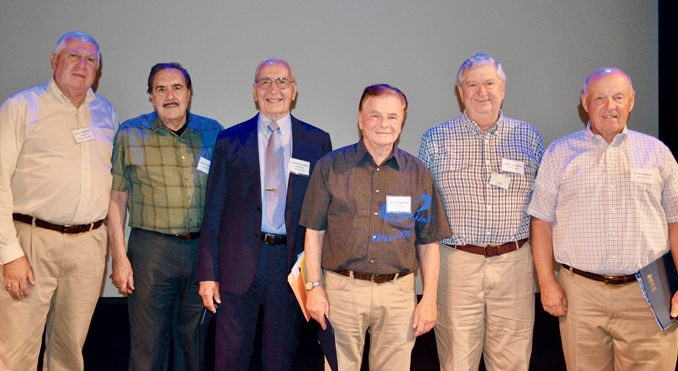
by Patria Baradi Pacis
On Saturday, July 20, the Montauk Observatory (MO) and Stony Brook University (SBU) hosted a five hour program at the Avram Theatre in Southampton to celebrate the 50th Anniversary of the Apollo 11 lunar landing of July 20, 1969. My husband and I lived in Queens and were only married a month when we watched, in awe, from a 12 inch black and white television, astronauts Neil Armstrong and Edwin (Buzz) Aldrin step down from the Lunar Excursion Module (LEM.) We listened, attentively, to Armstrong’s famous line, “That’s one small step for man, one giant leap for mankind” and felt proud when the US flag was planted while astronaut Michael Collins remained in the Command Module orbiting the moon. A month later, I remember climbing up a pole on Park Avenue to catch a glimpse of the astronauts during the New York’s Ticker Tape Parade. The excitement was out of this world!
MO’s President Terry Bienstock who brought memorabilia, opened the program by thanking the sponsors and more that 150 wannabe astronauts for coming. SBU Professor Timothy Glotch gave a talk entitled “50 Years of Lunar Science: What We’ve Learned From and Since Apollo 11.” Stony Brook scientists were the first to examine the 50 lbs lunar rocks collected and with the equipments left behind on the moon and six Apollo missions after, scientists were able to discover many facts such as the moon’s age, the existence of water and that the Earth and Moon are made of the same material.
Assemblyman Fred W. Thiele, Jr., introduced former Grumman employees Raymond LeCann, Anthony Mascolo Edward Whitman, Larry Jungblut and Leon Gurinsky and presented each a NYC Citation acknowledging their invaluable contribution to the Apollo 11 space program. In the past, men only dreamed of landing on the moon through science fiction movies and comic books. This reporter had no idea that exactly fifty years later, I would meet five of the 400,000 engineers and scientists responsible for this almost impossible feat.
Moderator LeCann, former VP and Director of the Lunar Module Data Reduction System (LDRS) the man who made sure all the equipment worked before sending the astronauts into space, explained how hard everyone worked with hardly any sleep and the long hours spent away from their families in building the LEM in Bethpage, Long Island. One consolation was that they met the astronauts in person and had discussions on how to improve each materials being used. In 1961, President John F. Kennedy’s
goal was to get an American man on the moon before the decade was over. A space race began between the U.S. and U.S.S.R. after the Russians in 1957, successfully launched Sputnik 1, the first satellite to orbit Earth. As a teenager, the Cold War was frightening especially worrying about fall out from bombs and practicing air raids by taking cover.
After a brief intermission, NASA software engineer Ben Feist closed the program with a screening of the full-length (93 mins) version of Todd Miller’s 2019 documentary that contained never-before-seen footage and audio recordings of NASA’s first manned Moon Landing. As the Production Team Leader Mr. Feist informed me that there were many challenges in restoring 11,000 hours of mission control audio used to bring the silent mission control footage back to life. This film is priceless and a must see.
When the astronauts toured the world fifty years ago, they were surprised to hear strangers say, “We did it!” instead of Americans did it. Armstrong died in 2012 at the age of 82. Aldrin and Collins in current television interviews cherished the thought that for one brief moment, the world was united as one, as human beings. When Collins was asked what he remembered best, he said that it was not the moon landing that impressed him, but the sight of the little, blue, planet Earth, about 240,000 miles below, seen from the window of the Command Module. This year is extra special to my husband and I. We celebrated our 50th Wedding Anniversary and renewed our vows in front of families and friends. Hopefully, with today’s advance technology available, we can witness another landing, this time on Mars.
The Montauk Observatory or MO (soon to be called Hamptons Observatory) is a 501(c)(3) nonprofit dedicated to fostering interest in science, particularly astronomy, through quality educational programs. Lectures and stargazing events are FREE and held througout the South Fork of Long Island. Donations are welcome and are tax deductible. Observatory programs (portable planetarium shows and guided tours of the night via telescope) are available for private parties. For more info kindly contact Executive Director Donna McCormick at MontaukObservatory@gmail.com or go to www.MontaukObservatory.com.

